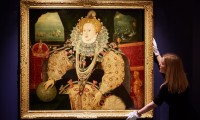 Thanks to an outpouring of support from the public and big donations from private organizations, the Armada Portrait of Queen Elizabeth I has been purchased by the Royal Museums Greenwich for £10 million ($13,225,500). It will now enter public ownership for the first time in its more than four centuries of existence.
Thanks to an outpouring of support from the public and big donations from private organizations, the Armada Portrait of Queen Elizabeth I has been purchased by the Royal Museums Greenwich for £10 million ($13,225,500). It will now enter public ownership for the first time in its more than four centuries of existence.
The Royal Museums Greenwich and the Art Fund launched the campaign needing to raise £8.6 million ($11,374,000) to meet the asking price for the painting. The museum had contributed its entire annual acquisitions budget, £400,000 ($530,000), the Art Fund £1 million, but unless they could come up with the full asking price, the painting would be auctioned off to the highest bidder.
 Painted in around 1590, the oil-on-panel depicts Queen Elizabeth I presiding serenely over a vast new global empire while in the windows behind her the English navy and divine intervention in the form of great winds defeat the Spanish Armada. The unusual landscape orientation, the queen’s lavish adornment, the famous sea battle in the background have made this portrait iconic, used in textbooks and period movies alike as a classic image of Elizabeth’s rule and the English Renaissance.
Painted in around 1590, the oil-on-panel depicts Queen Elizabeth I presiding serenely over a vast new global empire while in the windows behind her the English navy and divine intervention in the form of great winds defeat the Spanish Armada. The unusual landscape orientation, the queen’s lavish adornment, the famous sea battle in the background have made this portrait iconic, used in textbooks and period movies alike as a classic image of Elizabeth’s rule and the English Renaissance.
Two other versions of this portrait, probably by different unknown artists, are already in public museums, but this version is exceptional because it was owned by Sir Francis Drake, who probably commissioned it. Drake was vice admiral in command of the English fleet when it went up against the great Spanish Armada in 1588, so he was in the thick of the action depicted at Queen Elizabeth’s back. The painting has been passed down by his descendants ever since, for 425 years. When they decided to sell, the Tyrwhitt-Drake family offered the state first crack at it.
 The campaign was launched on May 23rd and quickly captured the public’s imagination. Prominent historians vocally supported the cause. Seven-year-old Christina Ryder threw a bake sale at her school to donate to the fund, making cupcakes with an awesome frosting Elizabeth I on top inspired by the Armada Portrait.
The campaign was launched on May 23rd and quickly captured the public’s imagination. Prominent historians vocally supported the cause. Seven-year-old Christina Ryder threw a bake sale at her school to donate to the fund, making cupcakes with an awesome frosting Elizabeth I on top inspired by the Armada Portrait.
An overwhelming response from the public saw 8,000 donations in just 10 weeks, with every donation matched pound for pound, raising £1.5m in total. Major contributions were made by the Linbury Trust, the Garfield Weston Foundation and the Headley Trust. In total, £10.3m has now been raised. The extraordinary level of support from the public makes this one of the most successful campaigns ever for a work of art.
Stephen Deuchar, Director, Art Fund, said, ‘This campaign has been a triumph of popular will. The painting captured the national imagination in 2016 as surely as the defeat of the Armada itself had done in 1588. Record numbers of donors, large and small, stepped forward with determination and generosity, creating an irresistible momentum that has brought this great work into public ownership at last.’
A big grant of £7.4 million ($9,787,000) from the Heritage Lottery Fund took them over the top.
The portrait will go on display at the newly renovated Queen’s House (construction completed in 1635), today part of the Royal Museums Greenwich. Designed by Inigo Jones, the Queen’s House was built just south of former Greenwich Palace, demolished in the 17th century, where Elizabeth I was born. The renovated museum will be able to maintain the fragile work in ideal environmental conditions. On October 11th, the portrait will be the star of the official reopening of the Queen’s House.
After a brief showing, the portrait will spend 2017 in treatment. It’s in dire need of conservation. It spent most of its life hanging over the mantlepiece of a fireplace in Shardeloes, the Buckinghamshire country house built for William Drake in the 18th century, ravaged by constant heat and moisture fluctuations, never kind to panel paintings. The all-important background was overpainted at same point in its past. There are areas of paint loss and varnish discoloration has given it an overall bilious hue. Once the Armada Portrait is conserved, cleaned and stabilized, it will go on permanent display at Queen’s House.
Here is historian David Starkey explaining the significance of the painting:
[youtube=https://youtu.be/U6lEq-5ScFw&w=430]